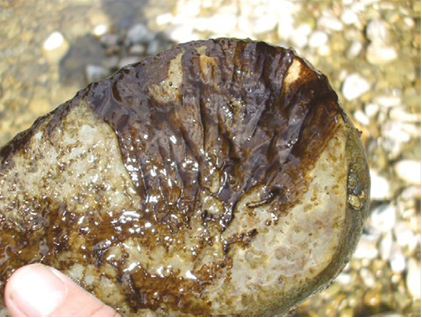
Current filter:

Keep Watch for Algal Blooms in Rivers & Lakes
With temperatures warming up, people using Hawke’s Bay’s lakes or stony rivers for swimming or walking dogs need to be aware of the risks of algae or bacteria growth.
Hawke’s Bay Regional Council’s water quality monitoring staff check water quality at 36 popular swimming spots around the region and also look out for algae growth. They are seeing higher levels of algal growth in waterways now.
Parts of the Tukituki River, in particular, are prone to algal growth in summer because of lower water flows, higher water temperatures and nutrients in the water. Green strand algae is commonly seen as the water warms but is harmless.
However the black Phormidium bacteria growth on the rocks is of more concern as it can turn toxic and becomes a hazard for humans and dogs. It can detach from the rocks and dry as mats on the sides of the rivers which can also be toxic.
“Always treat the black growth on rocks in the water and the drying mats as toxic, stay out of the water if you see it, and swim or walk your dog elsewhere,” says Anna Madarasz-Smith, HBRC’s Principal Scientist Marine and Coasts.
“At lakes keep away if the water is bright blue-green, especially if it looks like an oily, spilt paint spill on the surface. Water activities in Lakes Tūtira and Waikōpiro is advised against because of regular blooms.”
Science has not yet identified when Phormidium turns toxic or why, so to be safe it should always be treated as harmful. Contact with Phormidium bacteria can make people sick, with flu-like symptoms.
Dogs are more vulnerable. They are particularly attracted to the musty odour of the mats and their smaller bodies mean the toxins can be more dangerous. Dogs should be under control in river beds and not allowed to scavenge, and owners should take other water for their dogs to drink. The clinical symptoms are vomiting, diarrhoea and lethargy, and heat stroke-like symptoms such as muscle tremors, breathing difficulties, paralysis and convulsions. Dogs should be taken immediately to the vet.
Algae and phormidium occur naturally, even in very clean fresh water. As Regional Council staff cannot check whole river systems each week, they appreciate information and photos from the public. Information on locations can be phoned in to 0800 108 838 or emailed with photos to info@hbrc.govt.nz (subject Algae alert).
People can check water quality and algae warnings on the national environmental monitoring site LAWA (Land Air Water Aotearoa) at lawa.org.nz, searching the Can I Swim Here section.
People should also pay attention to warning signs that are put up at affected areas. It is best to go elsewhere to avoid contact with the Phormidium mats.
What to look for?
What is Phormidium?
Phormidium is a type of cyanobacteria, which are microbes that live in water environments and have characteristics in common with both bacteria and algae. They are widespread through lakes and rivers around New Zealand - including those with very good water quality. In warm, nutrient-rich conditions, free-floating cyanobacteria cells can multiply quickly. Large numbers of cyanobacteria form on mats on rocks in river and lake beds; these mats can sometimes detach and float to the surface. Some cyanobacteria species will produce toxins (cyanotoxins) which pose a risk to humans and animals when consumed in drinking water or by direct contact during recreational activities.
https://www.lawa.org.nz/learn/glossary/c/cyanobacteria/
https://www.niwa.co.nz/news/qa-bloomin-algae
5 December 2018
Disclaimers and Copyright
While every endeavour has been taken by the Hawke's Bay Regional Council to ensure that the information on this website is
accurate and up to date, Hawke's Bay Regional Council shall not be liable for any loss suffered through the use, directly or indirectly, of information on this website. Information contained has been assembled in good faith.
Some of the information available in this site is from the New Zealand Public domain and supplied by relevant
government agencies. Hawke's Bay Regional Council cannot accept any liability for its accuracy or content.
Portions of the information and material on this site, including data, pages, documents, online
graphics and images are protected by copyright, unless specifically notified to the contrary. Externally sourced
information or material is copyright to the respective provider.
© Hawke's Bay Regional Council - www.hbrc.govt.nz / +64 6 835 9200 / info@hbrc.govt.nz